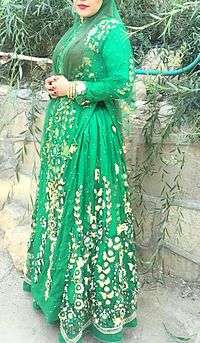Southern Lurs
Southern Lurs (Souhthern Lurish: لݸرَلِ جنۈبی) are a large part of Lurish people[1][2] who natively speak Southern Lurish language a branch of Western Iranian languages,[3][4] and are an Iranic people. They occupy some regions in Southwest of Iran including Kohgiluyeh and Boyer-Ahmad (fully), Sotheastern parts of Khuzestan (Behbahan, Omidiye, Hendijan, Ramhormoz and Bagh-e Malek counties) Northwestern parts of Fars (Mamasani, Rostam, Lamerd, Kazerun, Sepidan and Eqlid counties), and Western parts of Bushehr Province (Deylam, Ganaveh and Dashtestan counties).[5]

Demographics
The exact number of Southern Lurs is unknown, due to the absence of recent and extensive census data. The most recent documented statistics concerning their language are available for the year 1999, where is estimated about 900,000 ethnic population[6] (1.43% of the whole population in Iran).

Language
Southern Lurish language is the southernmost section of Lurish language family. Lurish is a Western Iranian language continuum spoken by the Lurs in Western Asia. Lurish language forms five language groups known as Feyli lurish,[7][8][9][10] Central Lurish, Bakhtiari,[1][2] Laki[11][12][13][14] and the Southern Lurish.[1][2] The Lurish language is derived and descended from Pahlavi language and in comparison with other Iranian languages has been less affected by foreign invaders language e.g. Arabic and Turkic.[15][15][16] An important feature of Southern Lurish is some common characteristics like plural suffixes (al, yal and gal) that is common with Northern Lurish dialects including Laki and Feyli lurish that are not seen in Bakhtiari and central (Minjai) Lurish. In northern parts, the language is highly amenable to Bakhtiari and in southern regions is slightly affected by Persian language.

Culture
The authority of tribal elders remains a strong influence among the nomadic population. It is not as dominant among the settled urban population. As is true in other Lurish communities and Kurdish societies, southern Lurish women have much greater freedom than women in other groups within the region.[17]
Souhthern Lurish clothing
As a subdivision of Lurish clothing,[18] a special clothing system distinguishes Southern Lurs form their adjacent societies. In recent years, due to cultural changes male clothing is very less in use but female clothing is commonplace.[19]

Southern Lurish dance
Southern Lurish tarditional dance is an integral section of their culture and probably grew in close association with traditional Lurish music.Southern Lurish dance includes both circle dance and dance double and like Kurdish dance it is mixed-gender that distinguishes them from other Muslim neighbors.[20] Dasmaal Baazi (handkerchief dance) a circle dance is the most popular dance and includes different performing styles like Ashtafi-manganaa. Chubazi (twig dance) is a special dance double that is performed in Celebrations and joys and is inspired by the heroic battles.[21]
Religion
Southern Lurs are predominantly Shia Muslims.[22][23]
Notable Persons
The most famous person of Southern Lurs is Rais Ali Delvari, an independence fighter and anti-British colonialism activist who organized popular resistance against the British troops in this clashes, Rais Ali was killed .Then the Britishs used pro-British tribes to scatter the enemy into the hinterland.At the end, local tribal leaders murdered the British vice consul (a Persian) in Shiraz. and now is commemorated as a national hero in Iran. KayLohraas Baatuli is a well-known local hero.[24] who fought for years against Reza Shah Pahlavi troops in Boyer Ahmad and Mamasani.
References
- 1 2 3 Erik John Anonby (2003). Update on Luri: How many languages?. Journal of the Royal Asiatic Society (Third Series), 13, pp 171-197. doi:10.1017/S1356186303003067.
- 1 2 3 G. R. Fazel, ‘Lur’, in Muslim Peoples: A World Ethnographic Survey, ed. R. V. Weekes (Westport, 1984), pp. 446–447
- ↑ Gernot Windfuhr, 2009, "Dialectology and Topics", The Iranian Languages, Routledge
- ↑ Languages preceded by question marks, and many of the varieties of Persian, are from other sources. The dialects of the Central Plateau are from the source provided there.
- ↑ امان الهی بهاروند. اسکندر: قوم لر، انتشارات آگاه، تهران، ۱۳۷۴
- ↑ https://www.ethnologue.com/language/luz
- ↑ Najm S. Mehdi, al-Fayli, Stockholm 2001.
- ↑ http://faylee.org/articles/doc111.htm
- ↑ Black-Michaud, J.. (1974). An Ethnographic and Ecological Survey of Luristan, Western Persia: Modernization in a Nomadic Pastoral Society. Middle Eastern Studies, 10(2), 210–228. Retrieved from http://www.jstor.org/stable/4282526
- ↑ Shoup, J.A.2011.Ethnic Groups of Africa and the Middle East: An Encyclopedia.ABC-CLIO, Incorporated. p.177
- ↑ B. Grimes (ed.), ‘Luri’, in Ethnologue (13th edition) (Dallas, 1996), p. 677; M. Ruhlen, A Guide to the World's Languages (Stanford, 1991), p. 327.
- ↑ H. Izadpan¯ah, Farhang-e Laki [Lexicon of Laki]: in Persian, (Tehran, 1978).
- ↑ Sengupta et al. Polarity and Temporality of High-Resolution Y-Chromosome Distributions in India Identify Both Indigenous and Exogenous Expansions and Reveal Minor Genetic Influence of Central Asian Pastoralists. AJHG 78; 2. 2006
- ↑ H. Izadpan¯ah, Farhang-e Lori [Lexicon of Luri] (Tehran, 1964).
- 1 2 Erik John Anonby, "Update on Luri: How many languages?" // Journal of the Royal Asiatic Society (Third Series), volume 13, issue 02, Jul 2003, pp 171–197.
- ↑ Don Stillo, "Isfahan-Provincial Dialetcs" in Encyclopædia Iranica. Excerpt: "While the modern SWI languages, for instance, Persian, Lori-Baḵtiāri and others, are derived directly from Old Persian through Middle Persian/Pahlavi".
- ↑ Edmonds, Cecil (2010). East and West of Zagros: Travel, War and Politics in Persia and Iraq 1913-1921. p. 188. ISBN 9789004173446.
- ↑ QaedRahmat, Issa (2014), Clothes of Feyli Lurs in Luristan, Ilam and Kermanshah (illustrated, revised reprint ed.), Motie Press, Qom
- ↑ Ziapour, Jalil (1967), Clothing of tribes, nomads and villagers in Iran (illustrated, revised reprint ed.), Aron, Tehran
- ↑ Kurds, Kurdistan, Part 4. "Dances and music", The Encyclopedia of Islam, Edited by C.E. Bosworth, E. van Donzel, B. Lewis & Ch. Pellat, Vol. V, KHE-MAHI, Leiden, E.J. BRILL Publishers, 1986, 1263 pp. (see p. 477).
- ↑ Elton Daniel and AliAkbar Mahdi, 2006, Culture and Customs of Iran, Westport,Greenwood Press, 210 pages
- ↑ "Foreign Affairs - When the Shiites Rise - Vali Nasr". Mafhoum.com. Retrieved 2014-01-27.
- ↑ "Quick guide: Sunnis and Shias". BBC News. 2006-12-11.
- ↑ تقوی مقدم، سیدمصطفی: تاریخ سیاسی کهگیلویه، تهران: مؤسسه مطالعات تاریخ معاصر ایران، 1377.